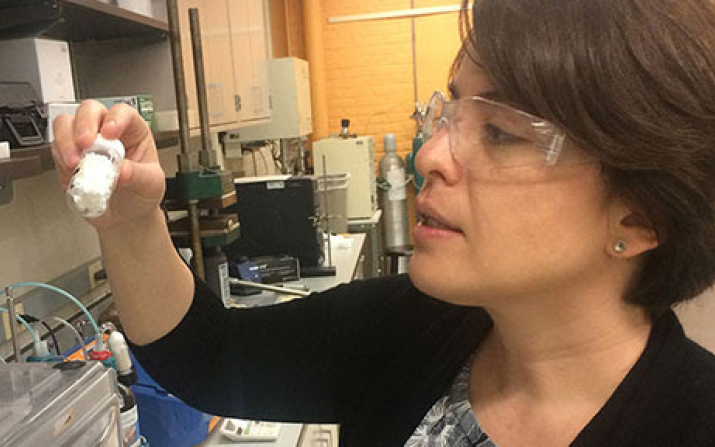
Groundbreaking research led by Case Western Reserve University team aims to convert greenhouse gas into valuable products with electricity

Researchers at Case Western Reserve University are developing ways to convert waste into fuels and other products, using processes that are energy efficient and powered by renewable sources.
More specifically, they’re close to resolving the challenge of converting carbon dioxide (CO2), a major greenhouse gas, into valuable chemicals using electricity.
CO2 can be a useful raw material for making commodity chemicals and fuels. But the process of creating the necessary reaction isn’t easy because it requires high pressures, high temperatures and special materials.
“Our modern society is in critical need of technologies that can capture the CO2 from waste—or even air—and convert it to products at benign conditions,” said Burcu Gurkan, professor of chemical engineering at Case School of Engineering. “Electrochemical conversion of carbon dioxide is an unresolved problem that is more than 150 years old.”
Until now, research has mainly focused on developing catalyst materials and understanding the energy-intensive CO2 conversion reaction in water-based electrolytes. Yet challenges remain because water-based systems have limited capacity for CO2. In addition, the process includes unwanted side reactions, such as hydrogen gas emissions.
But in a study published this fall in the European journal Angewandte Chemie, the Case Western Reserve research team demonstrated that the ionic liquids they developed effectively capture and convert CO2 in an electrochemical process.
Ionic liquids are salts that melt below 100 degrees celsius. The ones that Gurkan’s group developed are liquid at room temperature. These ionic liquids also are unique in that they have high capacity for CO2 capture and maintain electrochemical stability. As a result, the team achieved the desired electrochemical process.
“Our approach focuses on ionic liquid electrolytes that can alter the thermodynamics and product distribution due to kinetic effects which can be further tuned, thanks to the flexibility in ionic liquid design,” Gurkan said.
The study, led by Oguz Kagan Coskun, a doctoral student in Gurkan’s group, combined spectroscopic and electroanalytical techniques to reveal the fundamental mechanisms necessary for ionic liquids to activate the CO2 reduction reaction at the copper electrode surface.
The group reported needing less energy to drive the reaction and noted that it could lead to creation of a variety of industrially relevant products—without the unwanted side products found in the traditional electrolysis process.
Further, the report explains crucial aspects influencing the properties of the reaction environment for the effective use of CO2. This additional information contributes to a deeper understanding of reaction environment, especially concerning unconventional electrolytes.
The team plans to examine the individual reaction steps further to inform subsequent electrolyte designs. The ultimate goal: better control of the chemicals from the reaction and advance the electrochemical approaches to CO2 recycling.
The study’s co-authors include Case School of Engineering postdoctoral researcher Saudagar Dongare and doctoral student Aidan Klemm. The work was supported by Gurkan’s National Science Foundation CAREER award from the foundation’s Division of Chemical, Bioengineering, Environmental and Transport Systems.
Their research was complemented by quantum calculations by postdoctoral researcher Brian Doherty and Professor Mark Tuckerman, both at New York University.
Gurkan is also a researcher affiliated with 4C (Center for Closing the Carbon Cycle) that focuses on combined capture and electrochemical conversion of CO2. In addition, she is deputy director of CWRU’s BEES2 (Breakthrough Electrolytes for Energy Storage), which focuses on understanding fundamental electrochemical processes in structured electrolytes; both are Energy Frontier Research Centers of the U.S. Department of Energy.
